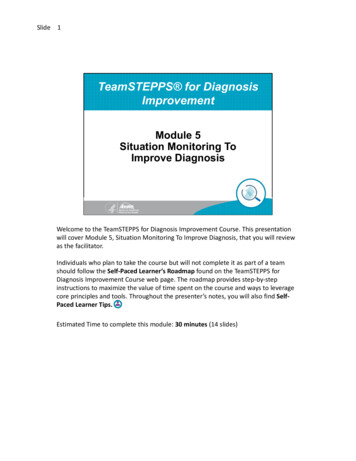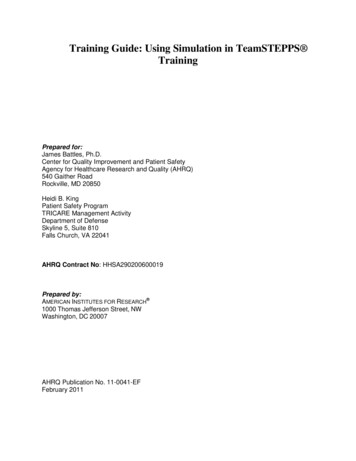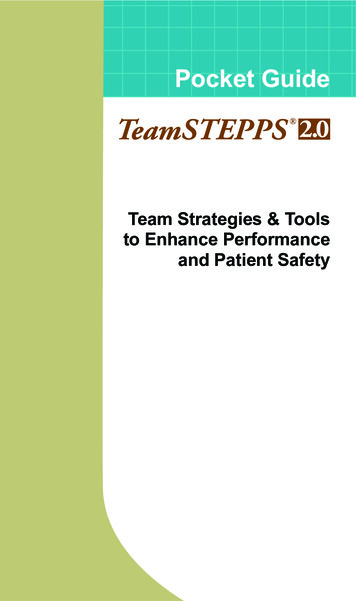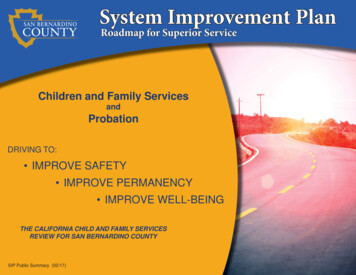
Transcription
Slide 1TeamSTEPPS for DiagnosisImprovementModule 5Situation Monitoring ToImprove DiagnosisWelcome to the TeamSTEPPS for Diagnosis Improvement Course. This presentationwill cover Module 5, Situation Monitoring To Improve Diagnosis, that you will reviewas the facilitator.Individuals who plan to take the course but will not complete it as part of a teamshould follow the Self‐Paced Learner’s Roadmap found on the TeamSTEPPS forDiagnosis Improvement Course web page. The roadmap provides step‐by‐stepinstructions to maximize the value of time spent on the course and ways to leveragecore principles and tools. Throughout the presenter’s notes, you will also find Self‐Paced Learner Tips.Estimated Time to complete this module: 30 minutes (14 slides)
Slide 2Module 5 Objectives Define how situation monitoring mayaffect diagnostic outcomes. Apply TeamSTEPPS reflectivepractice and communication tools toimprove diagnosis. Create a shared mental model forachieving a timely, accurate, andeffectively communicated diagnosis.After completing this module, participants will be able to: Define how situation monitoring may affect diagnostic outcomes. Apply TeamSTEPPS reflective practice and communication tools to improvediagnosis. Create a shared mental model for achieving a timely, accurate, and effectivelycommunicated diagnosis.
Slide 3Materials for This ModuleParticipant Workbook Team Assessment for SituationMonitoring Mr. Kane: Using STEP The Five “Whats” ofDiagnostic Reflective PracticeThe Diagnostic Journey of Mr. KaneFacilitator’s GuideDuring this course, the Participant Workbook is the primary tool for learners tocomplete the course activities, such as exercises, case‐based scenarios, and reflectivepractices. In addition to engaging in the content, tools, discussion questions, andother activities, participants can use the results of these activities to help shape localimprovement implementation plans. Select the link to download the ParticipantWorkbook.A separate Facilitator’s Guide is also provided for use by the site champion who willserve as the local course trainer. The guide includes detailed instructions pertaining tothe administration and implementation of course activities.This module will also refer to The Diagnostic Journey of Mr. Kane.
Slide 4Team Assessment for SituationMonitoring To Improve DiagnosisThe Participant Workbook includes the Team Assessment Tool for ImprovingDiagnosis. Participants should have completed the assessment at the beginning ofthe course after finishing Module 1, Introduction, and the course facilitator shouldhave created an average summary score using the team’s results.As a team, discuss the scores for each characteristic under the Situation Monitoringdimension. Invite the team to consider the average summary score compared withhow they individually ranked the Situation Monitoring characteristics. How does the average Summary Score on Situation Monitoring compare with theother TeamSTEPPS dimensions (Team Structure, Communication, Leadership, andMutual Support)? What are the highest scoring Situation Monitoring characteristics? What are the lowest scoring Situation Monitoring characteristics? How do team members at your site rate these characteristics?After discussing the scores, ask participants to identify together where the site hasthe most effective Situation Monitoring methods to support improved diagnosis andwhere the site has opportunities to improve.[Facilitator’s Tip: You can customize the slide to provide a summary of your site’sresults. Detailed instructions for completing the Team Assessment can be found inthe Facilitator’s Guide.][Self‐Paced Learner Tip: Take some time to reflect on your results using the samestrengths and opportunities for improvement questions above.]
Slide 5Why Situation Monitoring?Process of actively scanningbehaviors and actions to assesselements of the situation orenvironmentEnables team members toidentify potential issues or minordeviations earlySituation monitoring is defined as the process of actively scanning behaviors andactions to assess elements of the situation or environment. Situation monitoring is askill individual team members can acquire, practice, and improve. It enables teammembers to identify potential issues or minor deviations early enough to correct andhandle them before they become a problem or pose harm to the patient.Situation monitoring fosters mutual support by enhancing individual preparedness toassist other team members to improve diagnostic safety and team accountability. Italso ensures staff are supported in times of stress or production pressures or whenthe day is just not going according to plan. Situation monitoring provides a safety netfor both the patient and the team. Examples of situation monitoring include assessingthe patient’s condition, noting malfunctioning equipment, and being aware ofworkload spikes and stress levels among team members.It is important to engage the patient whenever possible. Stating explicitly that allteam members want to provide the highest quality and safe care and asking patientsand family members to speak up if they have questions or concerns about anythingthey see, hear, or experience fosters their engagement as central members of thediagnostic team.
Slide 5Every team member, from the front desk staff to the patient to the providers toadministrators in the office, plays an important role when considering situationmonitoring to improve diagnosis. Situation monitoring for diagnostic safety willrequire every team member to practice the skill of being situationally aware.Situational awareness allows a team to be resilient, capturing potentially harmfulerrors in the care process before they result in harm to the patient. For example, if amedical assistant is out sick, the front desk staff may realize that faxed test results arenot being entered into patients’ medical records as they normally would. Speaking upcould ensure results are entered into the records and potentially avert a missed orwrong diagnosis.(TeamSTEPPS for Office‐Based Care: Situation Monitoring, 2015)
Slide 6Situational Awareness Is Importantto the Patient-Provider RelationshipSituational awareness ensures the patientand provider are: On the same page, With the same set of facts, With an understanding of eachother’s values and goals, and With a shared understanding ofwhere things are at.Situational awareness provides an important way to prevent or catch diagnosticerrors. An important application of situational awareness is to assess thepatient‐provider relationship. Ideally, patients and providers are on the same page,with the same set of facts, understanding each other’s values and goals and “wherethings are at” in the diagnostic process. Many malpractice suits illustrate theproblems that arise when understanding and expectations are out of sync.
Slide 7Where do failures occur andwhat role do I play?Situation monitoring is important across each step of the diagnostic process.The National Academy of Medicine noted communication between team members,including between the patient and the care team, as a common point of failure acrossall facets and steps of the diagnostic process (National Academies of Sciences,Engineering, and Medicine, 2015).Examples of breakdowns in communication include: Failures in the patient accessing the healthcare system and engaging with thehealthcare team. Failure in information gathering. Failure in information integration. Failure in information interpretation. Failure to establish an explanation for the health problem. Failure to communicate the explanation. Failures in treatments and followup.One way to address the breakdowns and improve team effectiveness is to use across‐monitoring process.[Image source: National Academy of Medicine conceptualization of the diagnosticprocess, 2015.]
Slide 8Cross-MonitoringA process ofongoing monitoringto recognize risk orunfolding errorAn opportunity tointerrupt or correctan action or eventbefore harm orinjury to the patientoccursA goal of “watchingeach other’s back”Feedback to ensurethe proceduresare beingperformedappropriatelyCross‐monitoring is a process of ongoing monitoring of the care environment torecognize risks or unfolding errors.It allows individuals and teams to take steps to interrupt or correct an action or eventbefore harm or injury to the patient occurs. Commonly referred to as “watching eachother’s back,” cross‐monitoring involves monitoring all actions against the establishedplan and advocating or asserting a position or corrective action when the plan andactions differ or when risk is perceived as escalating and task assistance is needed.Cross‐monitoring actions include providing feedback and keeping track of fellow teammembers’ behaviors to ensure procedures are being performed appropriately.Cross‐monitoring is a form of active patient and caregiver advocacy and allows teammembers to check and correct their actions if necessary. Cross‐monitoring does notmean spying on other team members; rather, it is a way to provide a safety net or anerror prevention or error interruption mechanism for the team, ensuring thatmistakes or oversights are caught early.When all members of the team understand the role of each staff member in thediagnostic process and trust the intentions of their fellow team members, a strongsense of team orientation and a high degree of psychological safety result.(TeamSTEPPS for Office‐Based Care: Situation Monitoring, 2015)[Facilitator’s Tip: Ask learners to take a moment to reflect on an example in whichcross‐monitoring to improve diagnosis was successful and one in which cross‐monitoring should have been used but was not.]
Slide 9STEP Process forSituation MonitoringOne approach that helps with situation monitoring is to use the STEP process. TheSTEP process is a mnemonic tool that can help team members monitor the situationand the overall environment.The STEP process involves ongoing monitoring of the: Status of the patient: What are the patient’s status, vital signs, medications, andstress level? Team members: What/how are the team members doing? What is their workload,fatigue level, and stress level? What is the skill level of individual team members? Environment: Are the exam rooms properly stocked? Are the blood pressure cuffs,otoscope, ophthalmoscopes, and other equipment working properly? Do we needany special equipment for a procedure today? Do we have enough staff to handleall the patients? Progress toward the goal: What is the progress toward today’s goals? Forexample, how is the day going? Are we behind? Are patients waiting too long? Arethings being left undone because of time pressure? Is the patient care plan stillappropriate, or does it need to be revised?(TeamSTEPPS Fundamentals Course: Module 5. Situation Monitoring, 2019)(TeamSTEPPS for Office‐Based Care: Situation Monitoring, 2015)[Facilitator’s Tip: Additional situation monitoring tools and links to resources,including the AHRQ STEP video, are included in the Facilitator’s Guide.]
Slide 10Mr. Kane: Using STEPS - Status of the PatientT - Team MembersE - EnvironmentP - ProgressIn the Participant Workbook is the following STEP exercise based on The DiagnosticJourney of Mr. Kane. Review Mr. Kane’s case and consider the following questions todiscuss with participants.1. What was the presenting status of the patient at each of his clinic visits? As understood by the patient, Mr. Kane? As understood by his son? As understood by his primary care provider? As understood by his pulmonologist? As understood by his nephrologist?2. Who were the members of the diagnostic team? Did they see themselves as members of the same team? If not, how might that have been addressed?3. Did environmental factors play a role in Mr. Kane’s treatment? If so, what were they? Were they adequately addressed? If not, what might have been done differently?
Slide 104. How was Mr. Kane’s clinical progress measured and understood? By the patient? By his son? By his primary care provider? By his pulmonologist? By his nephrologist?5. Discuss: What actions might have improved Mr. Kane’s diagnostic journey?[Facilitator’s Tip: Additional questions to consider and discussion prompts areincluded in the Facilitator’s Guide.][Self‐Paced Learner Tip: Take some time to reflect on The Diagnostic Journey ofMr. Kane using the same questions above.]
Slide 11The Five “Whats” ofDiagnostic Reflective PracticeWhat do I KNOW?What is the evidence to support what I think?What may be biasing my thinking?What are the assumptions?What are the ALTERNATIVES?Does this make sense?What is an alternative viewpoint?What else can it be?What INFORMATION would help?What information is missing or uncertain?Have I listened to all team members?Do I know what the patient/family are thinking?What are the CONSEQUENCES?If this, what else?What is the worst it could be?How would this affect the patient and family?What are the next STEPS?Who will be affected/involved?What needs to be done and when?What is the plan for continuing assessment?A set of questions can help develop a reflective mindset and aid in the situationmonitoring process. The five‐question mnemonic “KAICS” (Know, Alternatives,Information, Consequences, Steps) was developed by the course team to help lookbeyond the first answer to consider other perspectives.Begin with what do I KNOW? Review objective and subjective data in light ofevidence, possible biases, and assumptions.What are the ALTERNATIVES? Explore what else could be going on. Avoid prematureclosure by considering at least three other possibilities. Question the first answer;reflect whether the answer makes sense, whether the evidence adds up, or whetherthere are other alternatives to explore. What do I see now that I did not see before?Where else can I get INFORMATION (or from whom)? Reflect on what is known andwhat is uncertain. Examine assumptions for bias. Do other members of the team havediverse ideas? Did anyone ask the patient and family for their perspectives? Listeningto all members of the team helps provide a more well‐rounded perspective of thesituation and may uncover additional information.What are the CONSEQUENCES? Actions have consequences, so if this, then what?You may imagine the worst case patient scenario to rule out possibilities andsafeguard against diagnostic errors. Consider the impact of your actions andrecommendations on the patient and family. Ask yourself, if this were my familymember, would I think the same way?
Slide 11What are the next STEPS? Developing an action plan involves who, what, how, andwhen. Diagnostic reflective practice includes action, communicating with the patientand family what will follow and how. What processes are involved? It is important tocontinuously assess and update the plan throughout the diagnostic journey.A reflective mindset of Asking, Listening, and Acting makes every facet of thediagnostic process safer and offers the potential for fewer missed diagnoses, delayeddiagnoses, and wrong diagnoses.The Participant Workbook includes an example demonstrating how the five‐questionKAICS mnemonic can be applied to a clinical diagnosis case.
Slide 12Module 5 Summary Situation monitoring enables team members toidentify potential issues before they become aproblem or pose harm to the patient. Situation monitoring has a direct impact ondiagnostic outcomes. Reflective practice and communication tools suchas STEP can improve diagnosis.In this module, participants learned that: Situation monitoring enables team members to identify potential issues beforethey become a problem or pose harm to the patient. Situation monitoring has a direct impact on diagnostic outcomes. Reflective practice and communication tools such as STEP can improve diagnosis.
Slide 13Course ModulesModule 1:IntroductionModule 4:LeadershipModule 2:DiagnosticTeam StructureModule 5:SituationMonitoringModule 3:CommunicationModule 6:MutualSupportModule 7:Putting It AllTogetherTeamSTEPPS for Diagnosis Improvement has seven modules dedicated to improvingdiagnostic communication and teamwork. Communication strategies and tools toovercome some of the breakdowns in teamwork and team communication areavailable in each module and the accompanying Participant Workbook.The TeamSTEPPS for Diagnosis Improvement modules are: Introduction. Diagnostic Team Structure. Communication. Leadership. Situation Monitoring. Mutual Support. Putting It All Together.
Slide 14Module 5 References National Academies of Sciences, Engineering, and Medicine. Improving Diagnosis inHealth Care. Balogh EP, Miller BT, Ball JR, eds. Washington, DC: National AcademiesPress; 2015. TeamSTEPPS Fundamentals Course: Module 5. Situation Monitoring. Content lastreviewed March 2019. Rockville, MD: Agency for Healthcare Research and /fundamentals/module5/igsitmonitor.html.Accessed January 10, 2022. TeamSTEPPS for Office-Based Care: Situation Monitoring. Content last reviewedSeptember 2015. Rockville, MD: Agency for Healthcare Research and dcare/module5/office sitmon-ig.html.Accessed January 10, 2022.The following are the list of references from this module.
STEP Process for Situation Monitoring One approach that helps with situation monitoring is to use the STEP process.The STEP process is a mnemonic tool that can help team members monitor the situation andthe overall environment. The STEP process involves ongoing monitoring of the: Statusof the patient:










